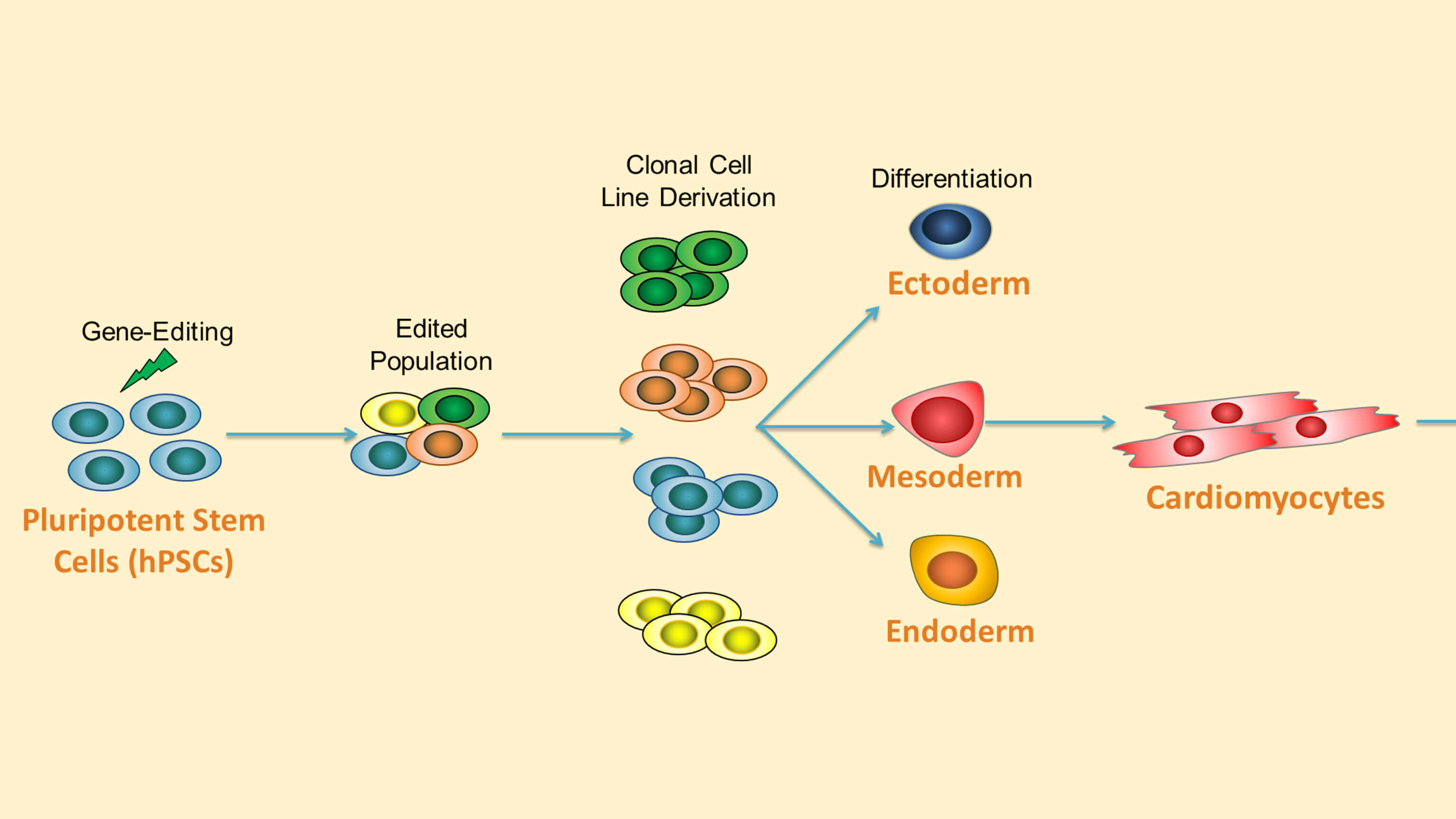Directed Differentiation and Disease Modeling
Human pluripotent stem cell (hPSC)-based models hold tremendous potential for studying human development and disease. Directed differentiation and disease modeling are two key methods for using hPSCs in drug discovery, cell therapy validation, and disease research.
- Directed differentiation of hPSCs refers to the in vitro differentiation of these cells toward a specific cell type through defined cell culture conditions. Directed differentiation is achieved by the addition of specific growth factors or small molecules.
- Disease modeling is an approach to study diseases using cells that display relevant pathological features. Disease modeling using hPSCs can be achieved by reproduction of a disorder-associated mutation with gene editing, isolation of embryonic stem cells (ESCs) from affected blastocysts; or generation of induced pluripotent stem cells (iPSCs) from patientsā€™ somatic cells.
Explore the resources below to support your disease modeling studies using hPSCs.
Highly Efficient Single-Cell Human Pluripotent Stem Cell Cloning and Robust Cardiomyocyte Differentiation
Recorded during the ISSCR 2017 Innovation Showcase in Boston, this tutorial highlights human pluripotent stem cell (hPSC) gene-editing and cardiac differentiation workflows using the CloneRā„¢ supplement and the STEMdiffā„¢ Cardiomyocyte System. This talk is presented by ŗŚĮĻ³Ō¹Ļā€™ Dr. Adam Hirst, scientist for pluripotent stem cell biology, and Dr. Vincenzo Macri, senior scientist for cardiomyocyte stem cell biology.
View Now >-
 Initiating Intestinal Organoid Differentiation from Single-Cell hPSCs Using STEMdiffā„¢<meta property="og:title" content="Using Single-Cell hPSCs for Intestinal Organoid Differentiation"/> <meta property="og:description" content="Want more control over your PSC cell populations for downstream differentiation? Check out our new protocol to learn how to prepare single cells for the use in intestinal organoid differentiations."/> <meta property="og:image" content="https://cdn.stemcell.com/media/images/social/PR00084-Intestinal-Organoid-Diff.jpg"/> <meta name="twitter:title" content="Using Single-Cell hPSCs for Intestinal Organoid Differentiation"/> <meta name="twitter:description" content="Want more control over your PSC cell populations for downstream differentiation? Check out our new protocol to learn how to prepare single cells for the use in intestinal organoid differentiations."/> <meta name="twitter:card" content="summary_large_image"/> <meta name="twitter:site" content="@ŗŚĮĻ³Ō¹ĻTech"/> <meta name="twitter:image" content="https://cdn.stemcell.com/media/images/social/PR00084-Intestinal-Organoid-Diff.jpg"/>
Initiating Intestinal Organoid Differentiation from Single-Cell hPSCs Using STEMdiffā„¢<meta property="og:title" content="Using Single-Cell hPSCs for Intestinal Organoid Differentiation"/> <meta property="og:description" content="Want more control over your PSC cell populations for downstream differentiation? Check out our new protocol to learn how to prepare single cells for the use in intestinal organoid differentiations."/> <meta property="og:image" content="https://cdn.stemcell.com/media/images/social/PR00084-Intestinal-Organoid-Diff.jpg"/> <meta name="twitter:title" content="Using Single-Cell hPSCs for Intestinal Organoid Differentiation"/> <meta name="twitter:description" content="Want more control over your PSC cell populations for downstream differentiation? Check out our new protocol to learn how to prepare single cells for the use in intestinal organoid differentiations."/> <meta name="twitter:card" content="summary_large_image"/> <meta name="twitter:site" content="@ŗŚĮĻ³Ō¹ĻTech"/> <meta name="twitter:image" content="https://cdn.stemcell.com/media/images/social/PR00084-Intestinal-Organoid-Diff.jpg"/> -
 iPSCs As Models, Part 1: What Are Induced Pluripotent Stem Cells and How Do You Use Them?Hear from Dr. Anjana Nityanandam, Director of the Human Stem Cell Lab core facility at St. Jude Childrenā€™s Research Hospital, as she provides some introductory examples of how iPSCs are used for disease modeling and walks through how to generate and characterize iPSCs. Learn about quality control measures to improve reliability and reproducibility of data, and how to address interline variability in your experiments.
iPSCs As Models, Part 1: What Are Induced Pluripotent Stem Cells and How Do You Use Them?Hear from Dr. Anjana Nityanandam, Director of the Human Stem Cell Lab core facility at St. Jude Childrenā€™s Research Hospital, as she provides some introductory examples of how iPSCs are used for disease modeling and walks through how to generate and characterize iPSCs. Learn about quality control measures to improve reliability and reproducibility of data, and how to address interline variability in your experiments. -
 Re-Creating Disease with Kidney Organoids and CRISPRIn this webinar, Dr. Benjamin Freedman from the University of Washington provides an overview of re-creating disease using kidney organoids and CRISPR-Cas9 genome editing. As a postdoctoral fellow in the Renal Division at Brigham and Womenā€™s Hospital at Harvard Medical School, Dr. Freedman was responsible for several innovative techniques that he describes in this webinar, including differentiation of human pluripotent stem cells (hPSCs) into kidney organoids containing nephron-like segments and generating knockout mutations in organoids with CRISPR.
Re-Creating Disease with Kidney Organoids and CRISPRIn this webinar, Dr. Benjamin Freedman from the University of Washington provides an overview of re-creating disease using kidney organoids and CRISPR-Cas9 genome editing. As a postdoctoral fellow in the Renal Division at Brigham and Womenā€™s Hospital at Harvard Medical School, Dr. Freedman was responsible for several innovative techniques that he describes in this webinar, including differentiation of human pluripotent stem cells (hPSCs) into kidney organoids containing nephron-like segments and generating knockout mutations in organoids with CRISPR. -
 iPSCs As Models, Part 2: Modeling the Human Brain with OrganoidsGet a walkthrough of how to generate and characterize iPSC-derived brain organoids from Dr. Anjana Nityanandam, Director of the Human Stem Cell Lab core facility at St. Jude Childrenā€™s Research Hospital. Learn how to improve reliability and reproducibility of data from brain organoid models, and get an overview of disease modeling case studies using various 3D cultures.
iPSCs As Models, Part 2: Modeling the Human Brain with OrganoidsGet a walkthrough of how to generate and characterize iPSC-derived brain organoids from Dr. Anjana Nityanandam, Director of the Human Stem Cell Lab core facility at St. Jude Childrenā€™s Research Hospital. Learn how to improve reliability and reproducibility of data from brain organoid models, and get an overview of disease modeling case studies using various 3D cultures. -
 How to Generate Uniform, Size-Controlled 3D Spheroid Cultures with AggreWellā„¢ Microwell PlatesLearn how AggreWellā„¢ Microwell Plates work to generate large numbers of uniform, size-controlled 3D cell culture spheroids for many areas of research, including cancer, stem cells, drug discovery and more
How to Generate Uniform, Size-Controlled 3D Spheroid Cultures with AggreWellā„¢ Microwell PlatesLearn how AggreWellā„¢ Microwell Plates work to generate large numbers of uniform, size-controlled 3D cell culture spheroids for many areas of research, including cancer, stem cells, drug discovery and more








